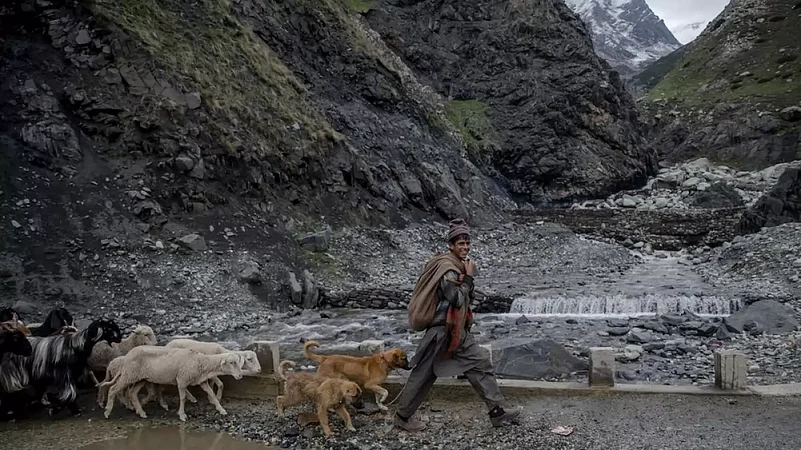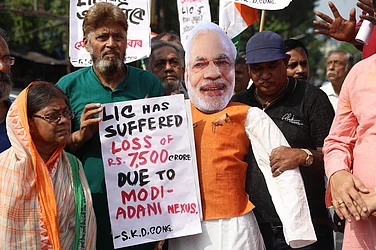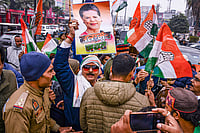In late October this year on a chilly winter afternoon, a group of men clad in traditional "khan suits" and caps appeared in Srinagar’s Lal Chowk. Their attire and gait were enough to catch the attention of passers-by. The men appeared resolute and entered a local hotel filled with journalists and announced that their “indigenous identity” was under threat.
“What you see are the indigenous people in front of you and our identity is at threat”, the group announced before the media. The group belonged to J&K’s Gujjar and Bakerwal Communities- semi-nomadic and nomadic tribes, who mostly live in sync with the nature. They were aghast over the Centre’s move to grant Scheduled Tribe (ST) status to the Pahari community on the basis of language.
They announced that they are going to rally across J&K under Gujjar & Bakerwal Joint Action Committee (GBJAC) to make their people aware of the consequences of the Centre’s move.
Who are Gujjar and Bakerwal tribes of J&K?
Gujjars and Bakerwals are among the tribes in J&K including Dard Shin, Gaddi who were declared Scheduled Tribes (ST) by the Centre in 1989 and 1991. The other tribes now fall in Ladakh, declared as separate Union Territory by Centre on 5 August 2019. They live across J&K districts including Rajouri, Poonch, Reasi, Kishtwar, Anantnag, Bandipora, Ganderbal and Kupwara.
Throughout the year, many of these nomadic communities are on the move, especially Bakerwals, who along with their herds of sheep and goat keep on migrating between green pastures of the Valley and the Pir Panchal belt. They brave difficult weather and tread through inaccessible areas. In summer, Bakerwals can be found in Kashmir’s meadows and in winter they usually move back to Poonch, Rajouri in Pir Panchal.
Gujjars, Bakerwals and Dard Shin of Bandipora’s Gurez whom the Greek historian Herodotus had also mentioned in his writings, are Muslims; while Sippi and Gaddi tribes are Hindus.
In 1990’s STs in J&K were provided 10 percent reservation in government jobs and institutions.
Recently, after the delimitation of J&K, nine seats have been reserved for STs among 90 seats. Seven seats were already reserved for SCs earlier.
According to the 2011 census, Gujjars and Bakerwals have the highest population among the tribes in J&K. The total tribal population of J&K as per the census is nearly 15 lakhs, of which Gujjars and Bakerwals comprise nearly 13 lakh people.
The major contention
The issue erupted after Union Home Minister Amit Shah’s rally in Rajouri this year in October. During his rally, Shah announced that Paharis will also get ST status in J&K, like Gujjars and Bakerwals.
Following Shah’s announcement, the J&K government amended its reservation rules. It extended 4 per cent reservation benefits in jobs and admissions in professional colleges of the UT to the ‘Pahari Ethnic Group’, in place of ‘Pahari Speaking People’. Subsequently, National Commission for Scheduled Tribes (NCST) approved inclusion of Paharis in the list of STs in J&K.
Gujjars and Bakerwals are opposing Pahari reservation since they feel that their inclusion will deprive them of the reservation benefits, since the community is much more literate and economically better off.
“How can a tribe living nomadic life compete with the people settled all across the country and abroad? They have got other avenues to prosper. Is this justified?” says Gujjar and Bakerwal activist, Talib Hussain.
The people from Gujjar and Bakerwal communities think, Hussain opines, that the constitutional criteria for reservation in the country has not been followed while giving reservation to the Pahari community.
As per rules for a tribe to be declared ST in the country, it should fulfil the following criteria:
a) it should have primitive traits
b) It should have a distinct culture
c) it should be geographically isolated
d) it should be economically backward
e) it should be shy of contact with community at large.
“There needs to be some ethnicity to such classifications. Do Bukahris and Rainas marry among themselves in J&K? ST classifications must reflect the linguistic and intersectional realities and relations between communities on ground. The GD Sharma report has been fabricated,” alleges Hussain.
GD Sharma Commission was set to determine the criteria to be adopted in considering any section of the people in the J&K UT as socially and educationally backward classes.
Like Hussain, another activist at the forefront of Gujjars and Bakerwals' fight is GBJAC’s general secretary Guftar Chowdhary.
Chowdhary said the prime reason for their agitation is the “injustice” meted out to their community. “In 15 percent reservation, now Gujjars and Bakerwals have to fight against upper castes, who are well off. Most of the Gujjars and Bakerwals live much below poverty line. How can you ask them to compete against privileged class?” asks Chowdhary.
Hussain and Chowdhary have been among the hundreds from Gujjar and Bakwerwal communities who rallied on foot from Kupwara to Pir Panchal against the Centre’s move.
Another major issue that Gujjars and Bakerwals are evoking is regarding the “irregularities” in their population.
“You see these surveys and censuses were done in March-April, when most of our community members are in process of migration. Only a section from the community has been registered in the country’s population, while others have been left out,” says Hussain.
To elucidate his point Hussain said during the 1941 census, population of Bakerwals was put at 82 thousand. “10 years down the line, in another cenus, population was put at 39000. Now tell me, shouldn’t the population have exceeded instead?” asks Hussain.
He also referred to Kokernag Assembly constituency in Valley, where he said total population is 1.52 lakh. “How can we be only 1 lakh 26 thousand as per 2011 census. Can a tribe be just this number , less than a constituency?” asked Hussain.
Hussain also adds that traditionally Gujjars and Bakerwals have large families, and are known to have several children.“What I mean is that census figures don’t depict the actual population of Gujjars and Bakerwals,” he said.
Meeting of Gujjars and Bakerwals with Centre
On November 28, the march was called off by group after the representatives from Gujjars and Bakerwals met Home Minister Amit Shah at his residence in New Delhi. It was after the rally was stopped at Kalakote in Rajouri and the group was asked to have talks with the government.
Shah, as per Chowdhary, who was part of the meeting, has assured the delegation that the bill will be brought in the Parliament, which will secure Gujjar and Bakerwal jobs, besides tribal identity. They were also told that the reservation for Paharis would nto affect their quotas.
However, the activists like Hussain and Chowdhary are apprehensive of the future.
They believe under the law there is no concept of “quota within quota”. Besides, they find that the law could be easily challenged in the Supreme Court, which will place Paharis at par with them through reservation.
Another apprehension among the community is related to reservation of jobs and admissions at Central level.
“Let us see if our demands are met and our apprehensions are cleared. We are keeping an eye on ongoing Parliament Winter Session,” says Chowdhary. They are currently preparing for long-term legal battle.
Chowdhary says that these might be mere “political stunt” as nine seats have recently been reserved for the STs in J&K by the Delimitation Commission.
“It is not hard to guess, who wants to benefit out of it,” adds Chowdhary.
The version of Paharis
On the other side, Paharis feel that they were neglected during the 1990s when ST status was granted to other tribes in J&K.
They claim that they live alongside Gujjar and Bakerwal communities, and face equal difficulties in healthcare, education, electricity and other facilities.
Paharis also live across J&K districts including Baramulla, Kupwara, Rajouri, Poonch and other parts.
“We equally face backwardness on socio-economic and geographical fronts. It is not like everyone is affluent in the community. There are downtrodden people among us. This is like other STs,” says young lawyer Naveed Bukhtiyar from Pahari community.
He said it is a “question of merit” and “competence” ultimately among the STs to reap the benefits.
Whatever the case, the ‘battle of reservation’ has heated J&K’s political landscape which otherwise has been facing chill post-August 5, 2019.


























